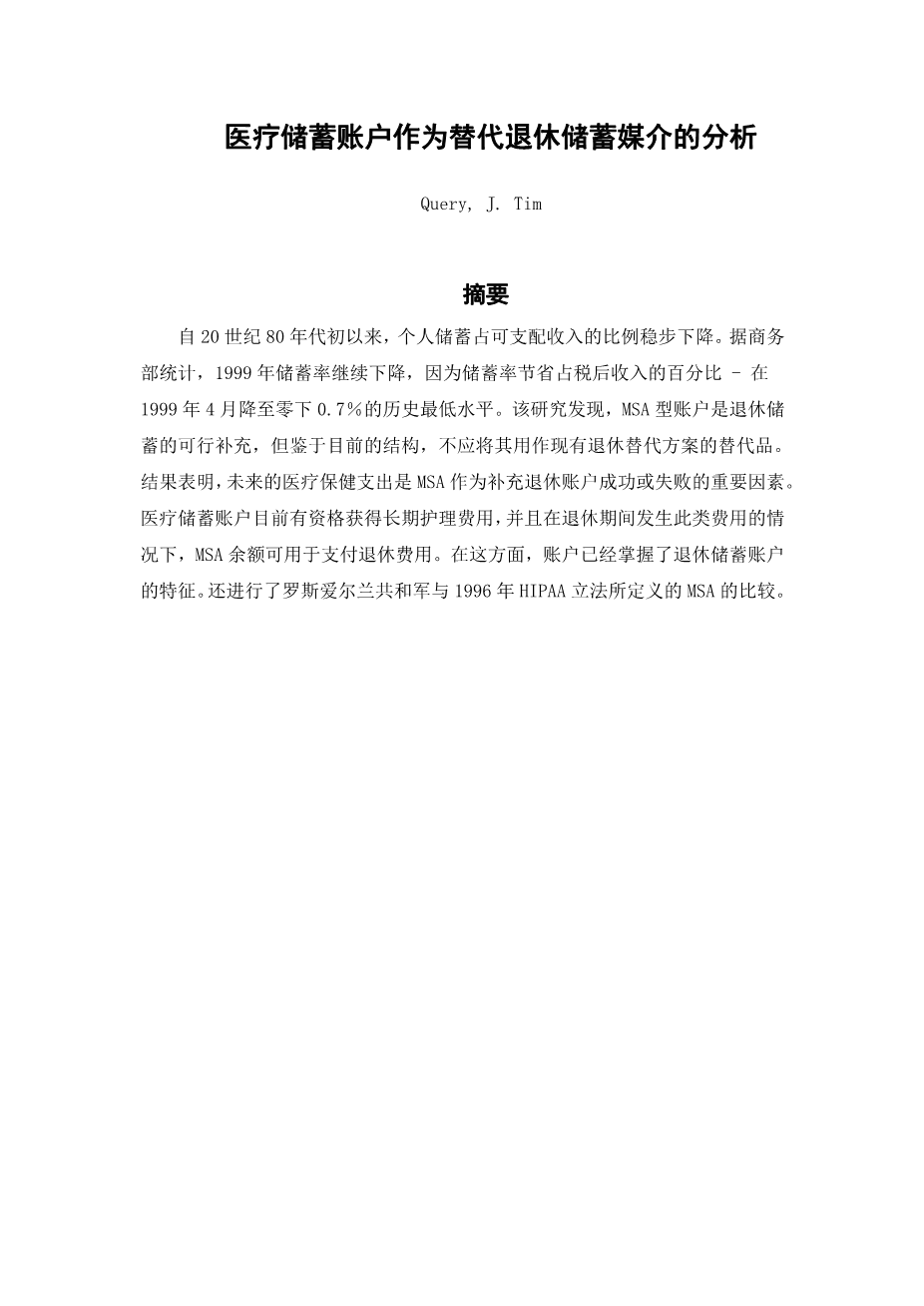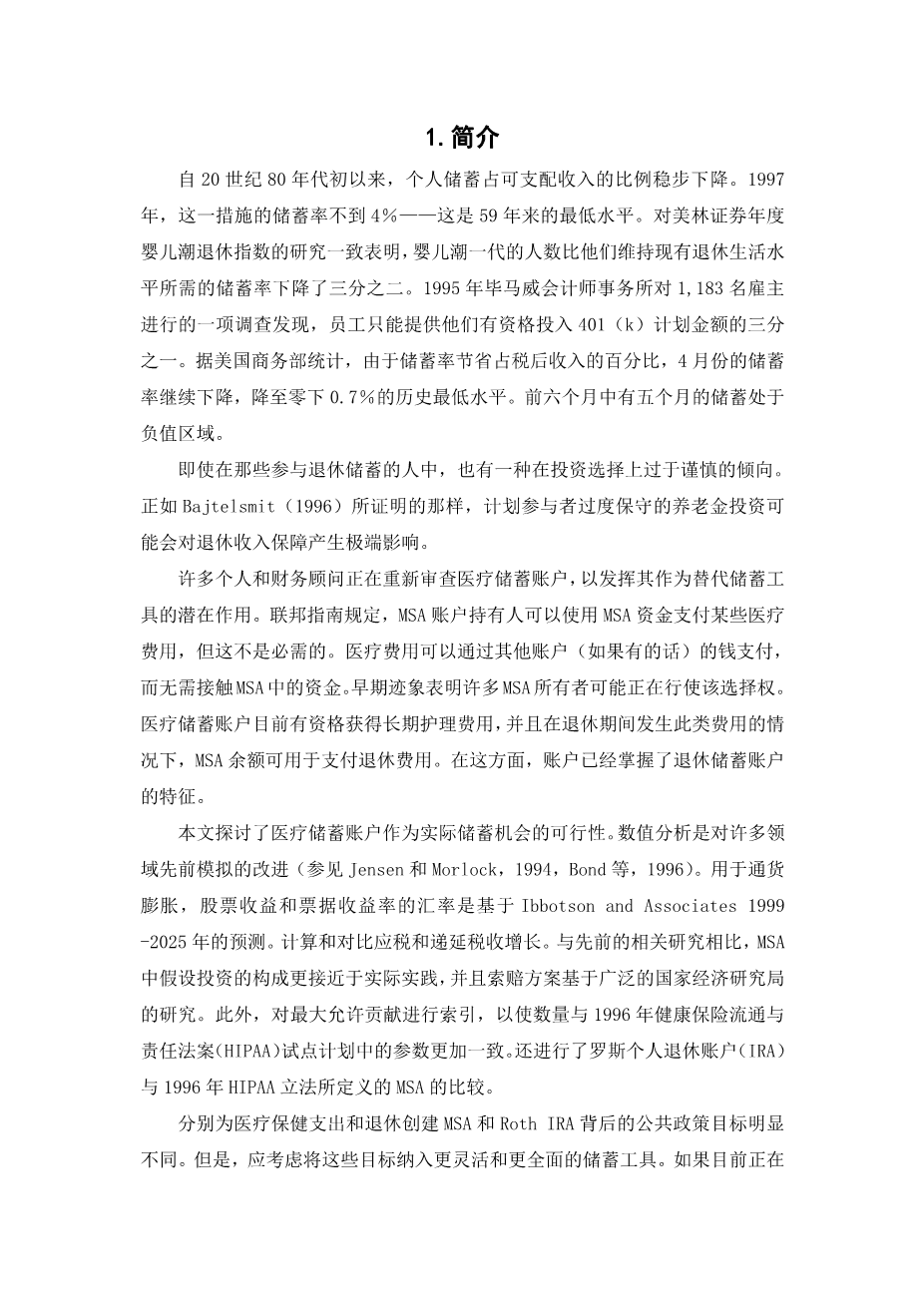An analysis of the Medical Savings Account as an alternative retirement savings Vehicle
Query, J. Tim
Abstract
Personal savings as a percentage of disposable income have dropped steadily since the early 1980s. Savings have continued to decline in 1999, as the savings rate—savings as a percentage of after-tax income—dropped to a record low of minus 0.7% in April 1999, according to the Department of Commerce. The study finds that MSA-type accounts are a viable supplement to retirement savings, but should not be used as a replacement for existing retirement alternatives given their current structure. Results show that future health care expenditures are an important factor in the success or failure of MSAs as supplemental retirement accounts. Medical Savings Accounts are currently eligible for long-term care expenses, and to the extent that such expenses occur during retirement, MSA balances could be used to pay for retirement expenses. In that respect the accounts already capture the characteristics of a retirement savings account. A comparison of the Roth IRA with the MSA as defined by the 1996 HIPAA legislation is also conducted.
1. Introduction
Personal savings as a percentage of disposable income have dropped steadily since the early 1980s. In 1997, the savings rate by this measure stood at less than four percent—the lowest rate in 59 years. Research for Merrill Lynchrsquo;s annual Baby Boom Retirement Index has consistently shown that the baby boomer generation has fallen as much as two-thirds behind the rate of savings that they need to maintain their current standard of living in retirement. A 1995 KPMG survey of 1,183 employers found that employees contribute only about one-third of the amount they are eligible to put into their 401(k) plans. Savings have continued to decline in 1999, as the savings rate—savings as a percentage of after-tax income—dropped to a record low of minus 0.7% in April, according to the Department of Commerce. Savings were in negative territory for five of the previous six months.
Even among those who do participate in retirement savings there is a tendency to be exceedingly cautious in their investment choices. As demonstrated by Bajtelsmit (1996), overly conservative pension investments by plan participants could have extreme consequences for retirement income security.
Many individuals and financial advisors are re-examining the Medical Savings Account for its potential role as an alternative savings vehicle. Federal guidelines state that an MSA account-holder can use MSA funds for certain medical expenses, but it is not required. Medical bills can be paid with money from some other account (if available) without touching the funds in the MSA. Early indications suggest that many MSA owners may be exercising that option. Medical Savings Accounts are currently eligible for long-term care expenses, and to the extent that such expenses occur during retirement, MSA balances could be used to pay for retirement expenses. In that respect the accounts already capture the characteristics of a retirement savings account.
This paper examines the feasibility of Medical Savings Accounts as a practical savings opportunity. The numerical analysis is a refinement of previous simulations in a number of areas (see Jensen and Morlock, 1994, Bond et al., 1996). Rates used for inflation, stock returns, and yields on bills are based on forecasts by Ibbotson and Associates for the years 1999–2025. Taxable and tax-deferred growth are computed and contrasted. The composition of assumed investments in the MSA more closely emulate actual practice than do prior related studies, and claims scenarios are based on an extensive National Bureau of Economic Research study. Also, the maximum allowable contribution is indexed in order to align the amounts more closely with the parameters found in the 1996 Health Insurance Portability and Accountability Act (HIPAA) pilot program. A comparison of the Roth Individual Retirement Account (IRA) with the MSA as defined by the 1996 HIPAA legislation is also conducted.
The public policy objectives behind the creation of the MSA and Roth IRA—saving for health care expenditures and retirement, respectively—are obviously different. However, consideration should be given to an integration of these objectives into a more flexible and comprehensive savings vehicle. If the composition of legislation currently being drafted is any indication, the structure of these two accounts may contain even more similarities in the future.
At the present time the option of saving through an MSA-type account is limited to the self-employed, employers with 50 or fewer employees, employees of firms with MSA plans (not necessarily eligible for federal tax incentives), and individuals not covered elsewhere. The results of this study should be of interest to individuals already using such plans, and to employers who have not previously considered the use of MSA plans as a benefit option.
2. An overview of medical savings accounts
The introduction of Medical Savings Accounts was motivated by two primary factors: rising health costs and a steady decline in private health insurance. With an MSA, people pay premiums to an insurer, but the premiums are lower because the policy has a high deductible that covers only catastrophic expenses. A major medical policy with a $2,500 deductible can often be purchased for about one-half the cost of a policy with a $250 deductible. Part of the money saved by the lower insurance premium is deposited to the Medical Savings Account. Individuals can withdraw funds from their MSA to pay smaller health care expenses below the deductible of their health insurance policy.
Underlying the concept of an MSA is the notion that the traditional health care financing system is inefficient for a number of reasons. F
全文共26068字,剩余内容已隐藏,支付完成后下载完整资料


英语译文共 11 页,剩余内容已隐藏,支付完成后下载完整资料
资料编号:[453284],资料为PDF文档或Word文档,PDF文档可免费转换为Word


